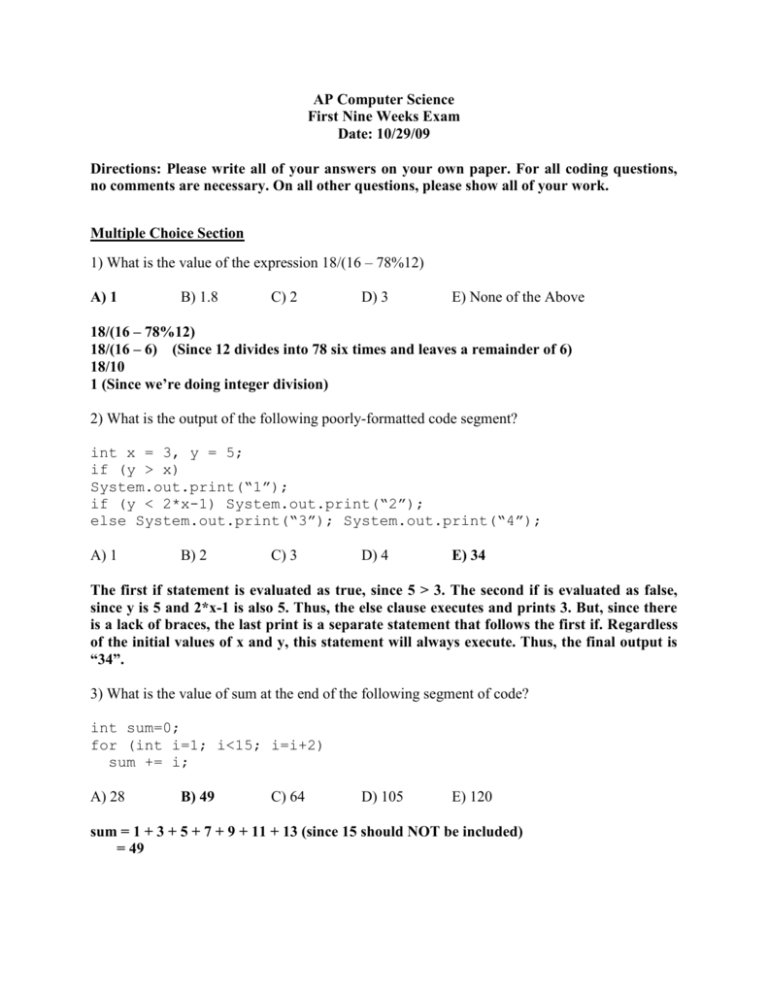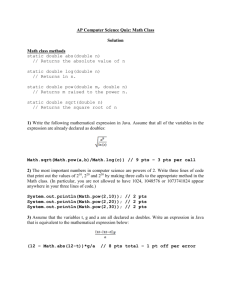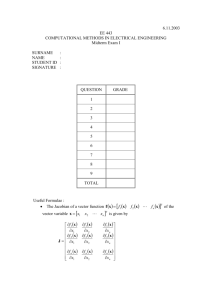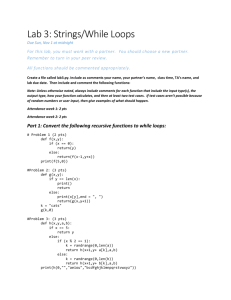Test #2 - Computer Science
advertisement

AP Computer Science
First Nine Weeks Exam
Date: 10/29/09
Directions: Please write all of your answers on your own paper. For all coding questions,
no comments are necessary. On all other questions, please show all of your work.
Multiple Choice Section
1) What is the value of the expression 18/(16 – 78%12)
A) 1
B) 1.8
C) 2
D) 3
E) None of the Above
18/(16 – 78%12)
18/(16 – 6) (Since 12 divides into 78 six times and leaves a remainder of 6)
18/10
1 (Since we’re doing integer division)
2) What is the output of the following poorly-formatted code segment?
int x = 3, y = 5;
if (y > x)
System.out.print(“1”);
if (y < 2*x-1) System.out.print(“2”);
else System.out.print(“3”); System.out.print(“4”);
A) 1
B) 2
C) 3
D) 4
E) 34
The first if statement is evaluated as true, since 5 > 3. The second if is evaluated as false,
since y is 5 and 2*x-1 is also 5. Thus, the else clause executes and prints 3. But, since there
is a lack of braces, the last print is a separate statement that follows the first if. Regardless
of the initial values of x and y, this statement will always execute. Thus, the final output is
“34”.
3) What is the value of sum at the end of the following segment of code?
int sum=0;
for (int i=1; i<15; i=i+2)
sum += i;
A) 28
B) 49
C) 64
D) 105
E) 120
sum = 1 + 3 + 5 + 7 + 9 + 11 + 13 (since 15 should NOT be included)
= 49
4) What is the value of sum at the end of the following segment of code?
int sum=0, number = 712467124;
while (number > 0) {
sum = sum + number%10;
number = number/10;
}
A) 0
sum=0
sum=4
sum=6
sum=7
sum=14
sum=20
sum=24
sum=26
sum=27
sum=34
B) 4
C) 34
D) 421764217
E) 712467124
number=712467124
number=71246712
number=7124671
number=712467
number=71246
number=7124
number=712
number=71
number=7
number=0
5) Which of the following expressions has exactly 20 possible values? (Assume that r refers to a
Random object already.)
A) r.nextInt()
B) Math.abs(r.nextInt())
C) Math.abs(r.nextInt()%20)
D) r.nextInt()%10
E) Math.abs(r.nextInt()%19) + 1
The possible values for choice C are 0 through 19, which is exactly 20 possible values.
The first two choices clearly have way too many possible values. Choice D and E have 19
possible values. The expression in D can range in between -9 and 9, while the expression in
E can range in between 1 and 19.
6) The boolean expression !(A || B) && C is equivalent to which of the following boolean
expressions
A) !(A || B && C)
B) !A || !B && C
C) !A && !B && C
D) !(A && B) || C
E) A || !(B && C)
In order for the given expression to be true, A must be false, B must be false and C must be
true. The only expression that requires these three things to be true is C. All other
expressions have more than one combination of variable settings to make it true.
7) Which best describes the method mystery below?
public static double mystery(int a, double b) {
double t = 1,
int s=0;
if (a < 0) { a=-a; s=1; }
while (a > 0) {
t = t*b;
a--;
}
if (s == 1) t = 1/t;
return t;
}
A) It returns the sum a+b
B) It returns the product a*b
C) It returns the exponent ab
a
D) It returns the exponent b
E) It returns (a+b)!
Each time through the while loop, we are multiplying t by b. The number of times this loop
runs (unless a is negative) is a. So, it’s calculating b being multiplied a times, or ba. For
negative a, we flip the sign and still multiply b, a positive number of times, But then we just
return the reciprocal as our answer, which is exactly what a negative exponent does.
8) What is the output of the following code segment?
int x=12, y=2;
while (x > 5) {
while (y < x) {
y++;
if (x%y == 1)
y = y+x;
}
x -= 2;
}
System.out.println(x + “ “ + y);
A) 4 23
B) 5 15
C) 12 2
D) 10 23
E) 4 22
The first time through the loop, when x is 12, y marches through the values 2, 3, 4, 5, 6, 7, 8,
9, 10 without the if statement triggering. Then, when y = 11, the if triggers, so y changes to
11+12, or 23. This immediately kicks out of the inner while loop. Next, x changes from 12 to
10. Since y is too big, the inner while loop is never entered again. Instead, x changes from
10 to 8, then 8 to 6 and finally from 6 to 4.
Grading: 6 points per MC question.
Free Response Section
Fill in the methods below that form a Stock class. A Stock object consists of a name (String), a
price (double), and a number of shares (int). Comments describe what each method is supposed
to do.
public class Stock {
private String name;
private double price;
private int numshares;
// Creates a stock object with the name n, price p and shares
// number of shares.
public Stock(String n, double p, int shares) {
name = n; // 3 pts
price = p; // 3 pts
numshares = shares; // 3 pts
}
// Changes the price of this stock by change, which may be
// positive or negative.
public void deltaPrice(double change) {
price = price + change; // 8 pts
}
// Splits a stock by doubling its number of shares and
// dividing its price by two.
public void split() {
price = price/2; // 5 pts
numshares = numshares*2; // 5 pts
}
// Creates and returns a new Stock object with name n that
// has 10% of the price of this Stock and the same number of
// shares. This stock’s price is subsequently reduced by 10%.
public Stock sisterFirm(String n) {
Stock sister = new Stock(n, .1*price, shares); // 10 pts
price = .9*price; // 4 pts
return sister; // 3 pts
}
// Returns a String representation of this Stock which
// includes just the name and price.
public String toString() {
return name+” “+price; // 8 pts
}
}







